What we’re Reading: December 15th
Point of View: A transatlantic perspective on 20 emerging issues in biological engineering studies
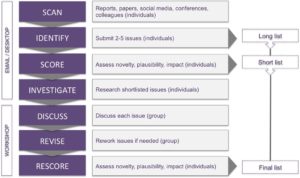 “Horizon scanning” describes the process of trying to rationally predict the future. Wintle et al. describe the results from a horizon-scanning exercise to identify emerging issues in biological engineering. The authors used an iterative approach to identify key issues in the near and longer-term future. In this Point of View, they elaborate on 20 issues of particular interest or relevance. Key issues relevant to plant scientists include Artificial photosynthesis and carbon capture for producing biofuels, Enhanced photosynthesis for agricultural productivitIy, and Producing vaccines and human therapies in plants, but the other topics are interesting and somewhat surprising to consider also. (Summary by Mary Williams) eLIFE 10.7554/eLife.30247
“Horizon scanning” describes the process of trying to rationally predict the future. Wintle et al. describe the results from a horizon-scanning exercise to identify emerging issues in biological engineering. The authors used an iterative approach to identify key issues in the near and longer-term future. In this Point of View, they elaborate on 20 issues of particular interest or relevance. Key issues relevant to plant scientists include Artificial photosynthesis and carbon capture for producing biofuels, Enhanced photosynthesis for agricultural productivitIy, and Producing vaccines and human therapies in plants, but the other topics are interesting and somewhat surprising to consider also. (Summary by Mary Williams) eLIFE 10.7554/eLife.30247
Plant RuBisCo assembly in E. coli with five chloroplast chaperones ($)
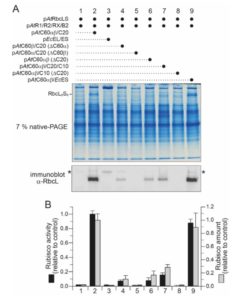 In plants, Ribulose-1,5-bisphosphate carboxylase/oxygenase (RuBisCo), the enzyme responsible for fixing carbon, is a made up of 8 each of the large and small subunits, making the L8S8 form. Efforts to study this enzyme have been thwarted by the inability to assemble an active L8S8 form in a heterologous expression system such as E. coli. Assembly of the plant enzyme is complicated by the fact that the although the large subunit is translated in the chloroplast, the small subunit is translated in the cytosol and then imported into the plastid in unfolded form. Aigner, Wilson et al. have for the first time successfully expressed and assembled plant RuBisCo in E. coli, by co-expressing it with several chloroplast chaperones (proteins that can facilitate protein folding). This opens the door for important structure-function studies (Summary by Mary Williams). Science. 10.1126/science.aap9221
In plants, Ribulose-1,5-bisphosphate carboxylase/oxygenase (RuBisCo), the enzyme responsible for fixing carbon, is a made up of 8 each of the large and small subunits, making the L8S8 form. Efforts to study this enzyme have been thwarted by the inability to assemble an active L8S8 form in a heterologous expression system such as E. coli. Assembly of the plant enzyme is complicated by the fact that the although the large subunit is translated in the chloroplast, the small subunit is translated in the cytosol and then imported into the plastid in unfolded form. Aigner, Wilson et al. have for the first time successfully expressed and assembled plant RuBisCo in E. coli, by co-expressing it with several chloroplast chaperones (proteins that can facilitate protein folding). This opens the door for important structure-function studies (Summary by Mary Williams). Science. 10.1126/science.aap9221
Review: The role of water in plant-microbe interactions ($)
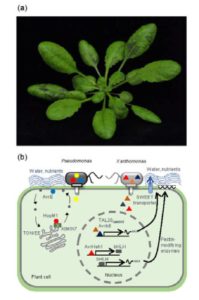 Water, a principal component on earth has also a fundamental role in maintenance of plants, microbes and the disease that is shaped by such interaction. Pathogenic disease outbreaks occur only in favorable environmental conditions, and atmospheric humidity is essential for pathogenesis. This review by Aung et al. provides a broad overview on the importance of water availability in host-microbe interactions including the effect of water on interactions between rhizosphere or phyllosphere microbes and the host, and on inducing stomatal defense. The second part of the review highlights the effect of water on microbes after entering the host, as seen in pathogenic bacteria Pseudomonas, by creating an aqueous environment in the apoplast. The work includes aspects of host fitness that are dependent on humidity e.g., R- gene mediated hypersensitive response, plant resistance under drought, and microbial-mediated drought tolerance in plants. Hence this work covers a new emerging aspect in host-microbe interaction biology. (Summary by Amey Redkar) Plant J. 10.1111/tpj.13795
Water, a principal component on earth has also a fundamental role in maintenance of plants, microbes and the disease that is shaped by such interaction. Pathogenic disease outbreaks occur only in favorable environmental conditions, and atmospheric humidity is essential for pathogenesis. This review by Aung et al. provides a broad overview on the importance of water availability in host-microbe interactions including the effect of water on interactions between rhizosphere or phyllosphere microbes and the host, and on inducing stomatal defense. The second part of the review highlights the effect of water on microbes after entering the host, as seen in pathogenic bacteria Pseudomonas, by creating an aqueous environment in the apoplast. The work includes aspects of host fitness that are dependent on humidity e.g., R- gene mediated hypersensitive response, plant resistance under drought, and microbial-mediated drought tolerance in plants. Hence this work covers a new emerging aspect in host-microbe interaction biology. (Summary by Amey Redkar) Plant J. 10.1111/tpj.13795
Chromatin region accessibility: cross-species comparisons and cell type distinctions
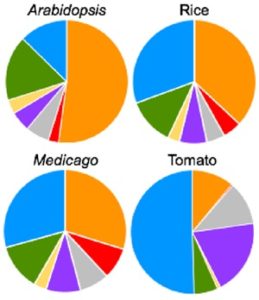 Cis-regulatory elements direct transcriptional output during cell differentiation and coordinate adaptive responses to environmental stress. DNA becomes open and accessible when nucleosomes are displaced by DNA-binding proteins, indicating a correlation between open chromatin regions and transcriptional regulation. Utilizing four different plant species and several distinct methods (i.e. INTACT for nuclei isolation and ATAC-seq for open chromatin identification), Maher et al. investigated cis-regulatory elements in accessible chromatin regions, (transposase hypersensitive sites or THSs), of isolated root tip nuclei. The overall proportion of THSs were similar in cross-species comparisons, with the majority of THSs being extragenic and within 3 kb upstream of a transcription state site. However, the number and location of open chromatin regions were highly variable. On average, genes tended to have only one THS, if any; orthologous genes displayed no conservation cross-species in the number or location of THSs; and THSs did not correlate with expression level. Extensive overlap was seen in THSs between distinct cell types, and THSs specific to a cell type, named differential THSs (dTHSs), were also found. Interestingly, dTHSs were found near abundantly- and minimally- or not-expressed genes. The authors demonstrated and compared multiple methods to explore chromatin accessibility in distinct cell types and constructed models of TF regulatory networks, providing valuable techniques to the field and a better understanding of the evolution of plant gene regulatory and cell fate specification mechanisms. (Summary by Alecia Biel) Plant Cell. 10.1105/tpc.17.00581.
Cis-regulatory elements direct transcriptional output during cell differentiation and coordinate adaptive responses to environmental stress. DNA becomes open and accessible when nucleosomes are displaced by DNA-binding proteins, indicating a correlation between open chromatin regions and transcriptional regulation. Utilizing four different plant species and several distinct methods (i.e. INTACT for nuclei isolation and ATAC-seq for open chromatin identification), Maher et al. investigated cis-regulatory elements in accessible chromatin regions, (transposase hypersensitive sites or THSs), of isolated root tip nuclei. The overall proportion of THSs were similar in cross-species comparisons, with the majority of THSs being extragenic and within 3 kb upstream of a transcription state site. However, the number and location of open chromatin regions were highly variable. On average, genes tended to have only one THS, if any; orthologous genes displayed no conservation cross-species in the number or location of THSs; and THSs did not correlate with expression level. Extensive overlap was seen in THSs between distinct cell types, and THSs specific to a cell type, named differential THSs (dTHSs), were also found. Interestingly, dTHSs were found near abundantly- and minimally- or not-expressed genes. The authors demonstrated and compared multiple methods to explore chromatin accessibility in distinct cell types and constructed models of TF regulatory networks, providing valuable techniques to the field and a better understanding of the evolution of plant gene regulatory and cell fate specification mechanisms. (Summary by Alecia Biel) Plant Cell. 10.1105/tpc.17.00581.
Mediator complex subunits in the regulation of phenylpropanoid biosynthesis ($)
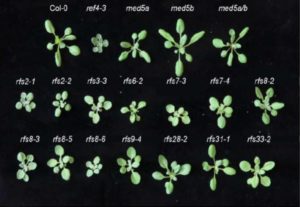 The Mediator complex is a transcriptional co-regulator that is conserved across kingdoms. Several subunits have been identified through genetic approaches in Arabidopsis. Recessive loss-of-function mutants of MED5 subunits cause phenylpropanoid overaccumulation, but ef4-3, a semi-dominant mutation of a MED5 subunit leads to dwarfism and decreased phenylpropanoid accumulation. Other studies suggest that MED5 may function as a regulatory node for the phenylpropanoid pathway. To learn more about this function, Dolan et al. screened for suppressor mutants of ef4-3. All but one of the lines identified occur in Mediator subunits, providing “strong genetic data for the interdependency of multiple Mediator subunits in the establishment of the ref4-3 phenotype”. Their analysis also showed that the effects of ref4-3 on growth and phenylpropanoid metabolism can be separated genetically. (Summary by Mary Williams) Plant Cell 10.1105/tpc.17.00282
The Mediator complex is a transcriptional co-regulator that is conserved across kingdoms. Several subunits have been identified through genetic approaches in Arabidopsis. Recessive loss-of-function mutants of MED5 subunits cause phenylpropanoid overaccumulation, but ef4-3, a semi-dominant mutation of a MED5 subunit leads to dwarfism and decreased phenylpropanoid accumulation. Other studies suggest that MED5 may function as a regulatory node for the phenylpropanoid pathway. To learn more about this function, Dolan et al. screened for suppressor mutants of ef4-3. All but one of the lines identified occur in Mediator subunits, providing “strong genetic data for the interdependency of multiple Mediator subunits in the establishment of the ref4-3 phenotype”. Their analysis also showed that the effects of ref4-3 on growth and phenylpropanoid metabolism can be separated genetically. (Summary by Mary Williams) Plant Cell 10.1105/tpc.17.00282
Plants increase CO2 uptake by assimilating nitrogen via the photorespiratory pathway
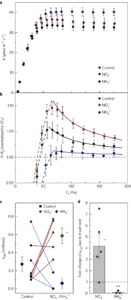 During photosynthesis Rubisco fixes CO2 by carboxylating its substrate RuBP, leading to the de novo production of carbohydrates. Photorespiration has long been considered a wasteful process, initiated by Rubisco-mediated oxygenation of RuBP and resulting in the loss of carbon, nitrogen and energy. Busch et al. demonstrate that photosynthetic carbon metabolism and nitrogen assimilation are intimately linked. Photorespiration can lead to the fixation of carbon into amino acids instead of carbohydrates, when serine and glycine are diverted away from the photorespiratory pathway. This confers substantial benefits under certain conditions, for example by providing an alternative carbon sink when triose phosphate utilization is limited. In addition, when the chloroplast stroma is highly reduced, photosynthetic reductant can be diverted away from the Calvin cycle to the cytosol in order to reduce nitrate and initiate nitrogen assimilation. As such, the Farquhar, von Caemmerer and Berry (FvCB) model, which aims to predict the rate of CO2 assimilation by Rubisco during photosynthesis, has been modified to account for these new observations. (Summary by Mike Page) Nat. Plants 10.1038/s41477-017-0065-x
During photosynthesis Rubisco fixes CO2 by carboxylating its substrate RuBP, leading to the de novo production of carbohydrates. Photorespiration has long been considered a wasteful process, initiated by Rubisco-mediated oxygenation of RuBP and resulting in the loss of carbon, nitrogen and energy. Busch et al. demonstrate that photosynthetic carbon metabolism and nitrogen assimilation are intimately linked. Photorespiration can lead to the fixation of carbon into amino acids instead of carbohydrates, when serine and glycine are diverted away from the photorespiratory pathway. This confers substantial benefits under certain conditions, for example by providing an alternative carbon sink when triose phosphate utilization is limited. In addition, when the chloroplast stroma is highly reduced, photosynthetic reductant can be diverted away from the Calvin cycle to the cytosol in order to reduce nitrate and initiate nitrogen assimilation. As such, the Farquhar, von Caemmerer and Berry (FvCB) model, which aims to predict the rate of CO2 assimilation by Rubisco during photosynthesis, has been modified to account for these new observations. (Summary by Mike Page) Nat. Plants 10.1038/s41477-017-0065-x
VASCULATURE COMPLEXITY AND CONNECTIVITY required for bilateral symmetry but not for dorsoventrality in Arabidopsis leaves
 The formation of the lobes at the Arabidopsis leaf margin are due to differences in local auxin accumulation, coordinated by auxin efflux carrier (PIN1) and transcriptional regulator (CUC2), but the molecular mechanisms acting upstream are not yet understood. Among viable leaf shape mutants, Wilson-Sanchez and colleagues identified that mutation of VASCULATURE COMPLEXITY AND CONNECTIVITY (VCC), also known as desigual1-1 (deal1-1), results in loss of bilateral symmetry, due to uncoordinated cell division at the leaf margins. The expression pattern of VCC coincides with basipetally regressing cell division. Spatial segregation between auxin maxima and CUC2 expression was disturbed in vcc mutants, suggesting that VCC is necessary for communication between growth promoting and repressing signals. Whether genes from the VCC family are guarding bilateral symmetry of other organs remains to be unveiled. (Summary by Magdalena Julkowska) New Phytol.
The formation of the lobes at the Arabidopsis leaf margin are due to differences in local auxin accumulation, coordinated by auxin efflux carrier (PIN1) and transcriptional regulator (CUC2), but the molecular mechanisms acting upstream are not yet understood. Among viable leaf shape mutants, Wilson-Sanchez and colleagues identified that mutation of VASCULATURE COMPLEXITY AND CONNECTIVITY (VCC), also known as desigual1-1 (deal1-1), results in loss of bilateral symmetry, due to uncoordinated cell division at the leaf margins. The expression pattern of VCC coincides with basipetally regressing cell division. Spatial segregation between auxin maxima and CUC2 expression was disturbed in vcc mutants, suggesting that VCC is necessary for communication between growth promoting and repressing signals. Whether genes from the VCC family are guarding bilateral symmetry of other organs remains to be unveiled. (Summary by Magdalena Julkowska) New Phytol.
Arabidopsis DEFECTIVE KERNEL1 regulates cell wall composition and axial growth in the inflorescence stem
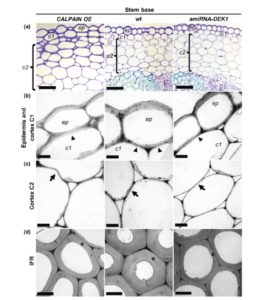 Plants can reach impressive heights, thanks to the mechanical stability provided by the cell walls. The required strength is ensured by coordination of cell wall deposition and cell expansion. Plant-specific calpain (DEK1) regulates axial stem growth, as lines overexpressing the calpain domain develop shorter stems than wild-type plants, while the opposite was observed for amiRNA lines targeting DEK1. The change in stem thickness was related to the cell number, shape and size, mainly in the cortical, interfascicular fiber region and pith layer cells. The deposition of pectin, cellulose and secondary cell wall components was affected in the mutant lines. The authors propose that altered cell wall composition impacts coordination of growth within and between cell layers. Whether increased cell wall thickness is a consequence or the cause for reduced elongation remains to be investigated in the future studies. (Summary by Magdalena Julkowska) Plant Direct
Plants can reach impressive heights, thanks to the mechanical stability provided by the cell walls. The required strength is ensured by coordination of cell wall deposition and cell expansion. Plant-specific calpain (DEK1) regulates axial stem growth, as lines overexpressing the calpain domain develop shorter stems than wild-type plants, while the opposite was observed for amiRNA lines targeting DEK1. The change in stem thickness was related to the cell number, shape and size, mainly in the cortical, interfascicular fiber region and pith layer cells. The deposition of pectin, cellulose and secondary cell wall components was affected in the mutant lines. The authors propose that altered cell wall composition impacts coordination of growth within and between cell layers. Whether increased cell wall thickness is a consequence or the cause for reduced elongation remains to be investigated in the future studies. (Summary by Magdalena Julkowska) Plant Direct
How do trees transport carbohydrates?
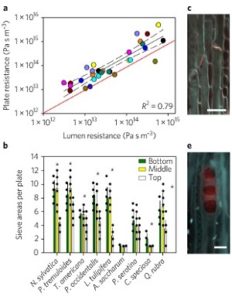 As a tree grows in height, increasing the length of the transport pathway, the hydraulic resistance of the vascular tissues should increase. It is not clear if trees only rely on passive transport mechanisms (no active loading of sugars) to move carbohydrates from shoots to roots. To answer this question, Savage and colleagues analyzed sieve tube anatomy using novel preparation and imaging techniques. They also measured the turgor pressure in the leaves of a red oak (Quercus rubra) in situ. They showed that the turgor pressures are of a magnitude to drive phloem transport, if the structural changes in the phloem including an increase in sieve element diameter and the area of seive pores, which collectively decrease transport resistance, are also present. Thus, plant height scales inversely with hydraulic resistance as there is a shift in sieve element structure along the length of the tree. (Summary by Julia Miller) Nature Plants 10.1038/s41477-017-0064-y
As a tree grows in height, increasing the length of the transport pathway, the hydraulic resistance of the vascular tissues should increase. It is not clear if trees only rely on passive transport mechanisms (no active loading of sugars) to move carbohydrates from shoots to roots. To answer this question, Savage and colleagues analyzed sieve tube anatomy using novel preparation and imaging techniques. They also measured the turgor pressure in the leaves of a red oak (Quercus rubra) in situ. They showed that the turgor pressures are of a magnitude to drive phloem transport, if the structural changes in the phloem including an increase in sieve element diameter and the area of seive pores, which collectively decrease transport resistance, are also present. Thus, plant height scales inversely with hydraulic resistance as there is a shift in sieve element structure along the length of the tree. (Summary by Julia Miller) Nature Plants 10.1038/s41477-017-0064-y
Trees are particularly robust to fixed somatic mutations
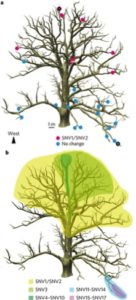 Plants lack a developmentally defined germline and gametes originate only late during plant development. This allows mutations acquired during the vegetative growth (somatic mutations) to be transmitted to the reproductive organs. The accumulation of mutations is relatively low in annual plants such as Arabidopsis, in which the fixed mutation rate is estimated at approximately one mutation per genome per generation. This rate has been hypothesized to be much higher in long-lived plants such as trees, but this has never been experimentally tested. In this study, the authors take advantage of an iconic 234-years-old oak tree located on the Lausane University Campus – the so-called Napoleon Oak – to assess the occurrence and dynamics of fixed somatic mutations in a long-lived plant. By sequencing the DNA of twenty-six leaf samples collected from different locations on the tree, they identified seventeen single-nucleotide variants (SNVs) only. The SNVs are not found randomly but cluster in a nested hierarchy, showing that the somatic mutations appeared gradually and became fixed in developmentally connected branches during tree development. Most of the SNVs observed are G:C to A:T transitions, likely induced UV stress and not replication errors. Altogether, this study shows that long-lived plants are particularly robust to the fixation of somatic mutations. It also suggests that occurrence of mosaicism in natural environments and during evolution might be higher than initially speculated. (Summary by Matthias Benoit) Nature Plants 10.1038/s41477-017-0066-9
Plants lack a developmentally defined germline and gametes originate only late during plant development. This allows mutations acquired during the vegetative growth (somatic mutations) to be transmitted to the reproductive organs. The accumulation of mutations is relatively low in annual plants such as Arabidopsis, in which the fixed mutation rate is estimated at approximately one mutation per genome per generation. This rate has been hypothesized to be much higher in long-lived plants such as trees, but this has never been experimentally tested. In this study, the authors take advantage of an iconic 234-years-old oak tree located on the Lausane University Campus – the so-called Napoleon Oak – to assess the occurrence and dynamics of fixed somatic mutations in a long-lived plant. By sequencing the DNA of twenty-six leaf samples collected from different locations on the tree, they identified seventeen single-nucleotide variants (SNVs) only. The SNVs are not found randomly but cluster in a nested hierarchy, showing that the somatic mutations appeared gradually and became fixed in developmentally connected branches during tree development. Most of the SNVs observed are G:C to A:T transitions, likely induced UV stress and not replication errors. Altogether, this study shows that long-lived plants are particularly robust to the fixation of somatic mutations. It also suggests that occurrence of mosaicism in natural environments and during evolution might be higher than initially speculated. (Summary by Matthias Benoit) Nature Plants 10.1038/s41477-017-0066-9
Genome-wide identification of Medicago peptides involved in macronutrient responses and nodulation
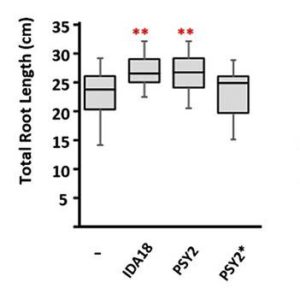 Plants are highly plastic and can modulate their growth and development to better respond to abiotic and biotic surroundings. Among the molecules involved in the adaptation to the environment, a crucial role is played by small secreted peptides (SSPs). In their paper, integrating 144 transcriptomic experiments, de Bang and colleagues were able to reannotate the Medicago truncatula genome and specifically identified thousands of new SSPs. They further characterize a subset of SSPs specifically influenced by macronutrient stresses or rhizobial interaction. In both cases the endogenous application of synthetic SSPs had a strong impact on plant development: the ones selected for being nutrient-responsive induced an arrest in primary root growth, while the application of legume-specific SSPs repressed the formation of nodules. The paper therefore shows the importance of SSPs as regulators of key plant processes. (Summary by Marco Giovannetti) Plant Physiol. 10.1104/pp.17.01096
Plants are highly plastic and can modulate their growth and development to better respond to abiotic and biotic surroundings. Among the molecules involved in the adaptation to the environment, a crucial role is played by small secreted peptides (SSPs). In their paper, integrating 144 transcriptomic experiments, de Bang and colleagues were able to reannotate the Medicago truncatula genome and specifically identified thousands of new SSPs. They further characterize a subset of SSPs specifically influenced by macronutrient stresses or rhizobial interaction. In both cases the endogenous application of synthetic SSPs had a strong impact on plant development: the ones selected for being nutrient-responsive induced an arrest in primary root growth, while the application of legume-specific SSPs repressed the formation of nodules. The paper therefore shows the importance of SSPs as regulators of key plant processes. (Summary by Marco Giovannetti) Plant Physiol. 10.1104/pp.17.01096
The rust fungus Melampsora larici-populina expresses distinct sets of secreted protein genes during infection of its two host plants, larch and poplar
 Rust fungi represent an important group of plant pathogens, many of which have heteroecious lifestyles (meaning that they require two alternate hosts). However, the molecular mechanisms used by these pathogens for suppression and colonization of multiple hosts are poorly understood. Lorrain et al. set out to dissect this in Melampsora larici-populina which infects two unrelated hosts, larch and poplar. The authors performed high-depth RNA sequencing of three developmental stages across infection of larch, and compared their data to available expression data during infection of poplar. This comparative transcriptomic approach highlighted subsets of genes expressed specifically or commonly on these different hosts. Genes encoding secreted proteins, including candidates for ‘effectors’, have highly dynamic and specific expression profiles specialized for each host. Hence, this study has illuminated new information about rust biology and identified genes contributing to host specificity in rust infections. (Summary by Amey Redkar) bioRxiv
Rust fungi represent an important group of plant pathogens, many of which have heteroecious lifestyles (meaning that they require two alternate hosts). However, the molecular mechanisms used by these pathogens for suppression and colonization of multiple hosts are poorly understood. Lorrain et al. set out to dissect this in Melampsora larici-populina which infects two unrelated hosts, larch and poplar. The authors performed high-depth RNA sequencing of three developmental stages across infection of larch, and compared their data to available expression data during infection of poplar. This comparative transcriptomic approach highlighted subsets of genes expressed specifically or commonly on these different hosts. Genes encoding secreted proteins, including candidates for ‘effectors’, have highly dynamic and specific expression profiles specialized for each host. Hence, this study has illuminated new information about rust biology and identified genes contributing to host specificity in rust infections. (Summary by Amey Redkar) bioRxiv
Plant extracellular vesicles are incorporated by a fungal pathogen and inhibit its growth ($)
 Extracellular vesicles (EVs) are membrane-released structures that play a role in cell-to-cell communication. These vesicles in plants have been poorly studied although they are predicted to have a role in defense upon pathogen infection. Regente et al. have characterized EVs from sunflower by transmission electron microscopy and proteomic analysis. As expected, the vesicles are enriched in defense proteins. They also inhibit the ability of a broad-range fungal pathogen, Sclerotinia sclerotiorum, to form infectious hyphae, and they arrests fungal growth and lead to fungal cell death. Membrane staining demonstrates that EVs are taken up by S. sclerotiorum ascospores. Hence this work demonstrates an important ability of plant EVs to interact and arrest fungal pathogens thereby blocking pathogen invasion. (Summary by Amey Redkar) J. Exp. Bot. 10.1093/jxb/erx355
Extracellular vesicles (EVs) are membrane-released structures that play a role in cell-to-cell communication. These vesicles in plants have been poorly studied although they are predicted to have a role in defense upon pathogen infection. Regente et al. have characterized EVs from sunflower by transmission electron microscopy and proteomic analysis. As expected, the vesicles are enriched in defense proteins. They also inhibit the ability of a broad-range fungal pathogen, Sclerotinia sclerotiorum, to form infectious hyphae, and they arrests fungal growth and lead to fungal cell death. Membrane staining demonstrates that EVs are taken up by S. sclerotiorum ascospores. Hence this work demonstrates an important ability of plant EVs to interact and arrest fungal pathogens thereby blocking pathogen invasion. (Summary by Amey Redkar) J. Exp. Bot. 10.1093/jxb/erx355
The Brassicaceae family displays divergent, shoot-skewed NLR resistance gene expression
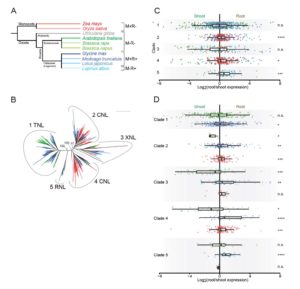 NLR (Nucleotide-binding site leucine-rich repeat resistance) genes help plants recognize pathogens. Munch et al. looked at expression pattern data of 1,235 NLRs from nine plant species. The distribution of NLR gene expression between shoot and root is relatively constant within a species, and for most species is skewed towards root-specific expression. This is interesting because most of the NLR/effector studies have been conducted in shoot, but not surprising considering the richness of the soil microbiome. However, in the Brassicaceae family the expression of NLR genes is skewed toward the shoot. The authors speculate that perhaps in this family secondary metabolites have taken over some of the defense roles from NLRs in the root, and also query whether the lack of mycorrhizal symbiosis in this family could be correlated with this observation. (Summary by Mary Williams) Plant Physiol. 10.1104/pp.17.01606
NLR (Nucleotide-binding site leucine-rich repeat resistance) genes help plants recognize pathogens. Munch et al. looked at expression pattern data of 1,235 NLRs from nine plant species. The distribution of NLR gene expression between shoot and root is relatively constant within a species, and for most species is skewed towards root-specific expression. This is interesting because most of the NLR/effector studies have been conducted in shoot, but not surprising considering the richness of the soil microbiome. However, in the Brassicaceae family the expression of NLR genes is skewed toward the shoot. The authors speculate that perhaps in this family secondary metabolites have taken over some of the defense roles from NLRs in the root, and also query whether the lack of mycorrhizal symbiosis in this family could be correlated with this observation. (Summary by Mary Williams) Plant Physiol. 10.1104/pp.17.01606



